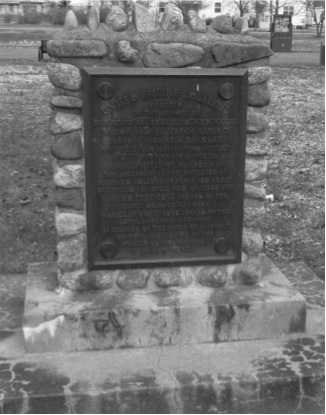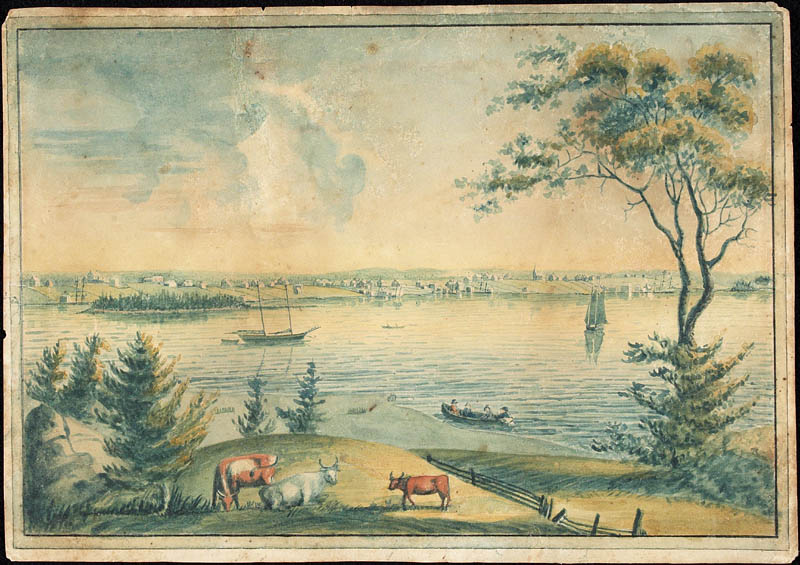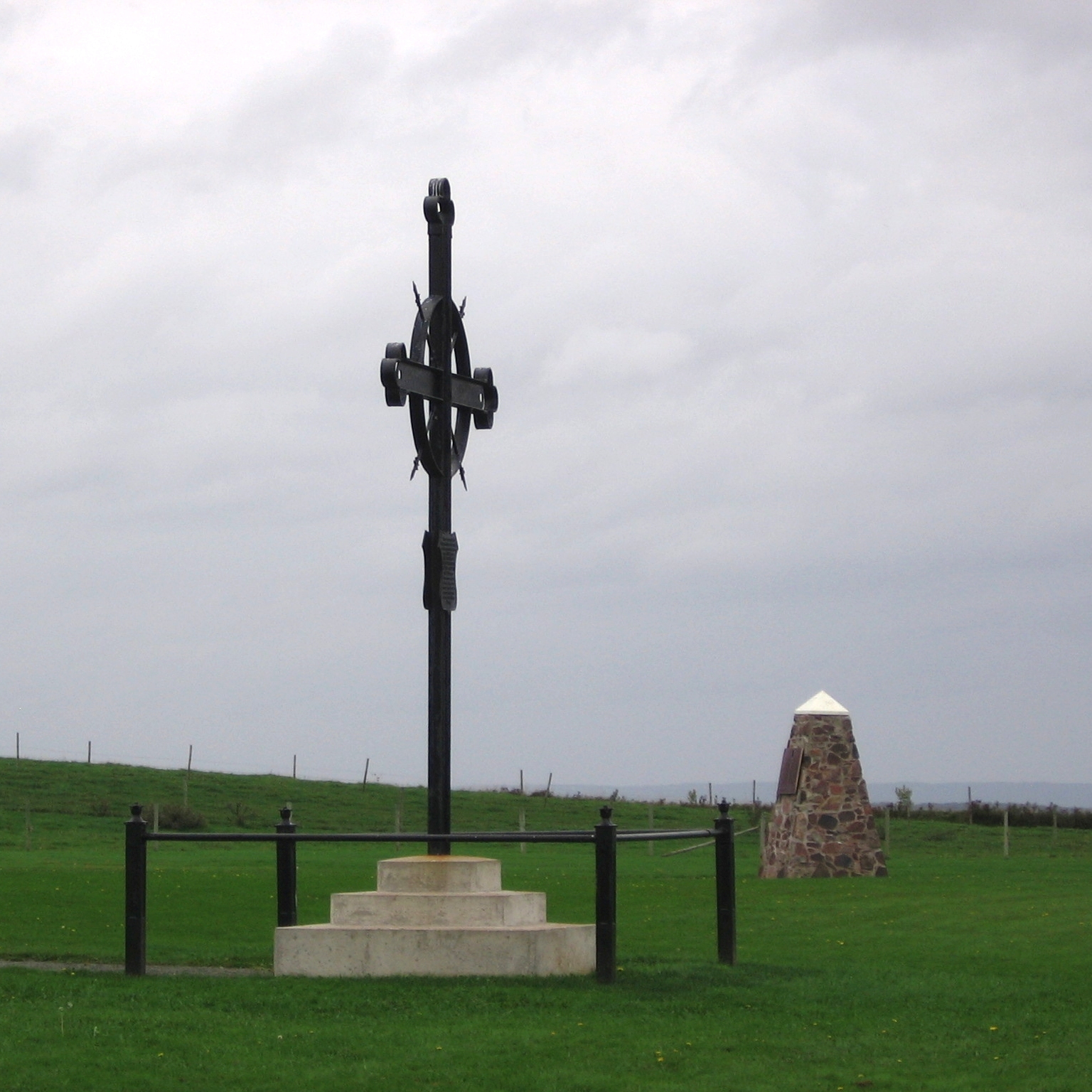|
Middleton, Nova Scotia
Middleton is a town in Annapolis County, Nova Scotia, Canada. Situated on the north bank of the Annapolis River, it is located close to the centre of the Annapolis Valley, from which it gets its nickname, "The Heart of the Valley". History Where the Annapolis River and the Nictaux river meet was a popular shad fishing spot for Mi'kmaq families before the arrival of the European settlers. It would be later settled by French Acadians that used these waterways to reach the capital of Port-Royal and farming. In the late 1750s the region was settled by New England Planters, and Loyalists to replace the ousted French Acadians. The first four families to be granted land there would later comprise the town of Middleton. They included families with names like Gates and Marshall and Richardson. Col. Philip Richardson received six lots of two hundred and fifty acres each, which ran from the Annapolis River half way to the Mountain to the north, while his neighbour to the west, Anthony M ... [...More Info...] [...Related Items...] OR: [Wikipedia] [Google] [Baidu] |
List Of Towns In Nova Scotia
A town is a type of municipality in the Canadian Province of Nova Scotia. Towns are incorporated by order by the Nova Scotia Utility and Review Board pursuant to sections 383 through 388 of Nova Scotia's ''Municipal Government Act''. Nova Scotia had 26 towns at the time of the 2016 Census. In 2016, the towns had a cumulative population of 97,495. Nova Scotia's largest and smallest towns are Truro and Annapolis Royal with populations of 12,261 and 491 respectively. List Former towns See also *Demographics of Nova Scotia *Geography of Nova Scotia * List of communities in Nova Scotia * List of counties of Nova Scotia * List of municipalities in Nova Scotia * List of villages in Nova Scotia References {{Canada topic, List of towns in Towns A town is a human settlement. Towns are generally larger than villages and smaller than cities, though the criteria to distinguish between them vary considerably in different parts of the world ... [...More Info...] [...Related Items...] OR: [Wikipedia] [Google] [Baidu] |
National Topographic System
The National Topographic System or NTS is the system used by Natural Resources Canada for providing general purpose topographic maps of the country. NTS maps are available in a variety of scales, the standard being 1:50,000 and 1:250,000 scales. The maps provide details on landforms and terrain, lakes and rivers, forested areas, administrative zones, populated areas, roads and railways, as well as other man-made features. These maps are currently used by all levels of government and industry for forest fire and flood control (as well as other environmental issues), depiction of crop areas, right-of-way, real estate planning, development of natural resources and highway planning. To add context, land area outside Canada is depicted on the 1:250,000 maps, but not on the 1:50,000 maps. History Topographic mapping in Canada was originally undertaken by many different agencies, with the Canadian Army’s Intelligence Branch forming a survey division to create a more standardized mapp ... [...More Info...] [...Related Items...] OR: [Wikipedia] [Google] [Baidu] |
CFB Greenwood
Canadian Forces Base Greenwood , or CFB Greenwood, is a Canadian Forces Base located east of Greenwood, Nova Scotia. It is primarily operated as an air force base by the Royal Canadian Air Force and is one of two bases in the country using the CP-140 Aurora and CP-140A Arcturus anti-submarine/maritime patrol and surveillance aircraft. Its primary RCAF lodger unit is 14 Wing, commonly referred to as 14 Wing Greenwood. RAF Station Greenwood The relatively fog-free climate of the farming hamlet of Greenwood was selected by the Royal Canadian Air Force (RCAF) and Royal Air Force for an airfield as part of the British Commonwealth Air Training Plan (BCATP), following the signing of that formal agreement on December 17, 1939. The airfield for RAF Station Greenwood was constructed between 1940 and 1942 with the first training units arriving as part of No. 36 Operational Training Unit (OTU) on March 9, 1942. Early training aircraft types included the Lockheed Hudson MK III, the ... [...More Info...] [...Related Items...] OR: [Wikipedia] [Google] [Baidu] |
Torbrook Iron Mines
Torbrook is a community in the Canadian province of Nova Scotia, located in Annapolis County. It is located on the South Mountain of Nova Scotia's Annapolis Valley to the east of the Nictaux River. The community was settled in the early 19th century by New England Planters and United Empire Loyalists from nearby Nictaux. Residents chose the name "Torbrook" in 1856 from an old English word meaning "Where the brook comes out of the hill." Iron deposits were discovered and mined on a small scale for about 15 years in mid 1800s and then on a larger scale beginning in 1890 by the Canadian Iron Company. The area around the mines became known as Torbrook Mines. By 1910, the Canada Iron Company's No. 2 Mine at Torbrook Mines was employing 120 men to produce 11,000 tons of iron ore a year. The ore was shipped from the 3 & 1/2 mile long spur to Nictaux and then 55 miles on the Halifax and Southwestern Railway to Port Wade, Nova Scotia Port Wade is a community in the Canadian provi ... [...More Info...] [...Related Items...] OR: [Wikipedia] [Google] [Baidu] |
2021 Canadian Census
The 2021 Canadian census was a detailed enumeration of the Canadian population with a reference date of May 11, 2021. It follows the 2016 Canadian census, which recorded a population of 35,151,728. The overall response rate was 98%, which is slightly lower than the response rate for the 2016 census. It recorded a population of 36,991,981, a 5.2% increase from 2016. Planning Consultation on census program content was from September 11 to December 8, 2017. The census was conducted by Statistics Canada, and was contactless as a result of the COVID-19 pandemic in Canada. The agency had considered delaying the census until 2022. About 900 supervisors and 31,000 field enumerators were hired to conduct the door-to-door survey of individuals and households who had not completed the census questionnaire by late May or early June. Canvassing agents wore masks and maintained a physical distance to comply with COVID-19 safety regulations. Questionnaire In early May 2021, Statistics Ca ... [...More Info...] [...Related Items...] OR: [Wikipedia] [Google] [Baidu] |
Yarmouth, Nova Scotia
Yarmouth is a town in southwestern Nova Scotia, Canada. A port town, industries include fishing, and tourism. It is the terminus of a ferry service to Bar Harbor, Maine, run by Bay Ferries. History Originally inhabited by the Mi'kmaq, the region was known as "Keespongwitk" meaning "Lands End" due to its position at the tip of the Nova Scotia peninsula. European settlement The region was visited in 1604 by Samuel de Champlain, who named it "Cap-Fourchu", meaning "forked or cloven cape." The first Europeans to make a settlement on these shores were the French Acadians. They set up a small fishing settlement known as "Tebouque" in the mid 1600s and by 1750 the population was 50 people. During the Seven Years' War, New England Planters settled at what is now the town of Yarmouth in 1759; the grantees were from Yarmouth, Massachusetts and they requested that Yarmouth be named after their former home. Yarmouth was founded on June 9, 1761, when a ship carrying three families arriv ... [...More Info...] [...Related Items...] OR: [Wikipedia] [Google] [Baidu] |
Halifax (former City)
Halifax is the capital and largest municipality of the Provinces and territories of Canada, Canadian province of Nova Scotia, and the largest municipality in Atlantic Canada. As of the 2021 Census, the municipal population was 439,819, with 348,634 people in its urban area. The regional municipality consists of four former municipalities that were Amalgamation (politics), amalgamated in 1996: History of Halifax (former city), Halifax, Dartmouth, Nova Scotia, Dartmouth, Bedford, Nova Scotia, Bedford, and Halifax County, Nova Scotia, Halifax County. Halifax is a major economic centre in Atlantic Canada, with a large concentration of government services and private sector companies. Major employers and economic generators include the Canadian Armed Forces, Department of National Defence, Dalhousie University, Nova Scotia Health Authority, Saint Mary's University (Halifax), Saint Mary's University, the Halifax Shipyard, various levels of government, and the Port of Halifax. Agricult ... [...More Info...] [...Related Items...] OR: [Wikipedia] [Google] [Baidu] |
Expulsion Of The Acadians
The Expulsion of the Acadians, also known as the Great Upheaval, the Great Expulsion, the Great Deportation, and the Deportation of the Acadians (french: Le Grand Dérangement or ), was the forced removal, by the British, of the Acadian people from parts of a Canadian-American region historically known as ''Acadia'', between 1755–1764. The area included the present-day Canadian Maritime provinces of Nova Scotia, New Brunswick, and Prince Edward Island, and the present-day U.S. state of Maine. The Expulsion, which caused the deaths of thousands of people, occurred during the French and Indian War (the North American theatre of the Seven Years' War) and was part of the British military campaign against New France. The British first deported Acadians to the Thirteen Colonies, and after 1758, transported additional Acadians to Britain and France. In all, of the 14,100 Acadians in the region, approximately 11,500 were deported, at least 5,000 Acadians died of disease, starvat ... [...More Info...] [...Related Items...] OR: [Wikipedia] [Google] [Baidu] |
New England Planters
The New England Planters were settlers from the New England colonies who responded to invitations by the lieutenant governor (and subsequently governor) of Nova Scotia, Charles Lawrence, to settle lands left vacant by the Bay of Fundy Campaign (1755) of the Acadian Expulsion. History Eight thousand Planters (roughly 2000 families), largely farmers and fishermen, arrived from 1759 to 1768 to take up the offer. The farmers settled mainly on the rich farmland of the Annapolis Valley and in the southern counties of what is now New Brunswick but was then part of Nova Scotia. Most of the fishermen went to the South Shore of Nova Scotia, where they got the same amount of land as the farmers. Many fishermen wanted to move there, especially since they were already fishing off the Nova Scotia coast. The movement of some 2000 families from New England to Nova Scotia in the early 1760s was a small part of the much larger migration of the estimated 66,000 who moved to New York's M ... [...More Info...] [...Related Items...] OR: [Wikipedia] [Google] [Baidu] |
Port-Royal (Acadia)
Port-Royal (1629–1710) was a settlement on the site of modern-day Annapolis Royal, Nova Scotia, part of the French colony of Acadia. The original French settlement of Port-Royal (Habitation de Port-Royal (1605-1613, about southwest) had earlier established farms in the area. In 1629, William Alexander (the younger) established a Scottish colony at the site and named it Charles Fort. Upon the handing back of Acadia to the French by the Treaty of Saint-Germain-en-Laye (1632) the settlement was occupied by the French and renamed Port-Royal. For most of the period until the Siege of Port Royal by the Kingdom of Great Britain in 1710, the village was the capital of Acadia. Port-Royal was the primary Acadian settlement until Acadians migrated out of the community to Pisiguit, Cobequid, Grand Pre, and Beaubassin (Isthmus of Chignecto) in the 1680s. Context The Habitation at Port-Royal was established on the other side of the river by Pierre Du Gua de Monts, with the a ... [...More Info...] [...Related Items...] OR: [Wikipedia] [Google] [Baidu] |
Mi'kmaq
The Mi'kmaq (also ''Mi'gmaq'', ''Lnu'', ''Miꞌkmaw'' or ''Miꞌgmaw''; ; ) are a First Nations people of the Northeastern Woodlands, indigenous to the areas of Canada's Atlantic Provinces and the Gaspé Peninsula of Quebec as well as the northeastern region of Maine. The traditional national territory of the Mi'kmaq is named Miꞌkmaꞌki (or Miꞌgmaꞌgi). There are 170,000 Mi'kmaq people in the region, (including 18,044 members in the recently formed Qalipu First Nation in Newfoundland.) Nearly 11,000 members speak Miꞌkmaq, an Eastern Algonquian language. Once written in Miꞌkmaw hieroglyphic writing, it is now written using most letters of the Latin alphabet. The Mi'kmaq, Maliseet, and Pasamaquoddy nations signed a series of treaties known as the Covenant Chain of Peace and Friendship Treaties with the British Crown throughout the eighteenth century; the first was signed in 1725, and the last in 1779. The Miꞌkmaq maintain that they did not cede or give up their l ... [...More Info...] [...Related Items...] OR: [Wikipedia] [Google] [Baidu] |








